Lyons W.C. (ed.). Standard handbook of petroleum and natural gas engineering.2001- Volume 1
Подождите немного. Документ загружается.

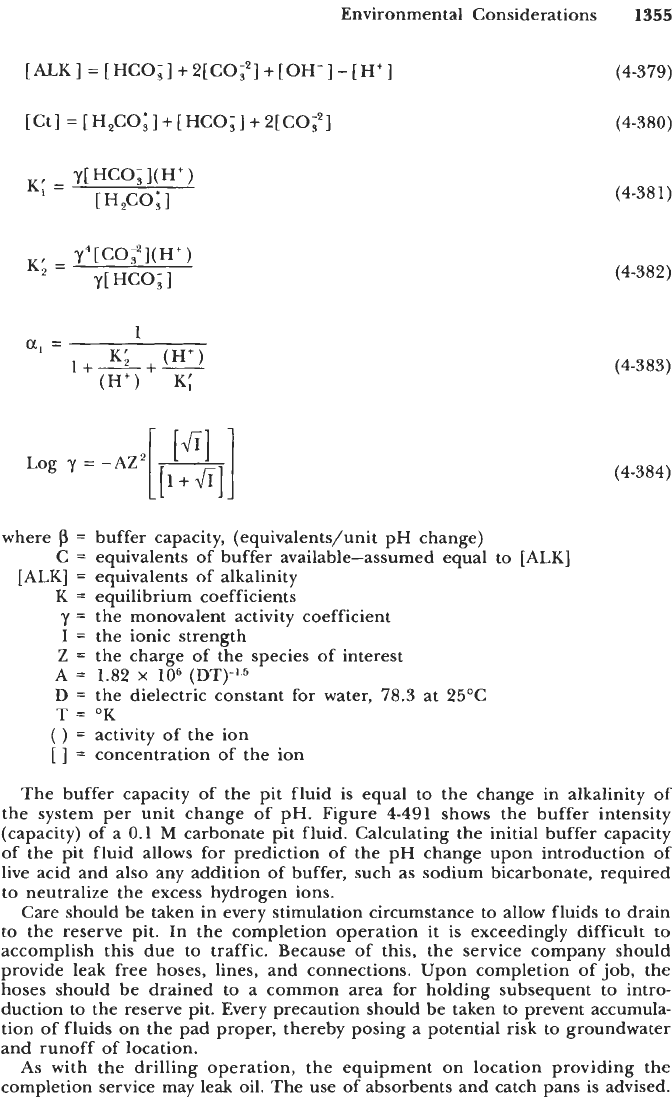
Environmental Considerations
1355
[
ALK
]
=
[
HCO;
3
+
2[
CO;'
]
+
[OH-]
-
[
H'
]
(4-379)
[Ct]
=
[H2CO~]+[HCO;]+2[C0;2] (4-380)
1
K'
(H')
1+2+-
a,
=
(H')
K;
(4-38
1)
(4-382)
(4-383)
(4-384)
where
=
buffer capacity, (equivalents/unit pH change)
C
=
equivalents of buffer available-assumed equal to
[ALK]
[ALK]
=
equivalents of alkalinity
K
=
equilibrium coefficients
y
=
the monovalent activity coefficient
I
=
the ionic strength
Z
=
the charge of the species of interest
A
=
1.82
x
lo6
(DT)-'.5
D
=
the dielectric constant
for
water, 78.3 at 25°C
T
=
OK
( )
=
activity of the ion
[
]
=
concentration of the ion
The buffer capacity
of
the pit fluid is equal to the change in alkalinity of
the system per unit change
of
pH. Figure 4-491 shows the buffer intensity
(capacity) of a
0.1
M
carbonate pit fluid. Calculating the initial buffer capacity
of the pit fluid allows for prediction of the pH change upon introduction of
live acid and also any addition of buffer, such as sodium bicarbonate, required
to neutralize the excess hydrogen ions.
Care should be taken in
every
stimulation circumstance to allow fluids to drain
to the reserve pit. In the completion operation it is exceedingly difficult to
accomplish this due to traffic. Because of this, the service company should
provide leak free hoses, lines, and connections. Upon completion of job, the
hoses should be drained
to
a common area for holding subsequent to intro-
duction to the reserve pit. Every precaution should be taken to prevent accumula-
tion of fluids on the pad proper, thereby posing a potential risk to groundwater
and runoff of location.
As
with the drilling operation, the equipment on location providing the
completion service may leak oil. The use of absorbents and catch pans is advised.
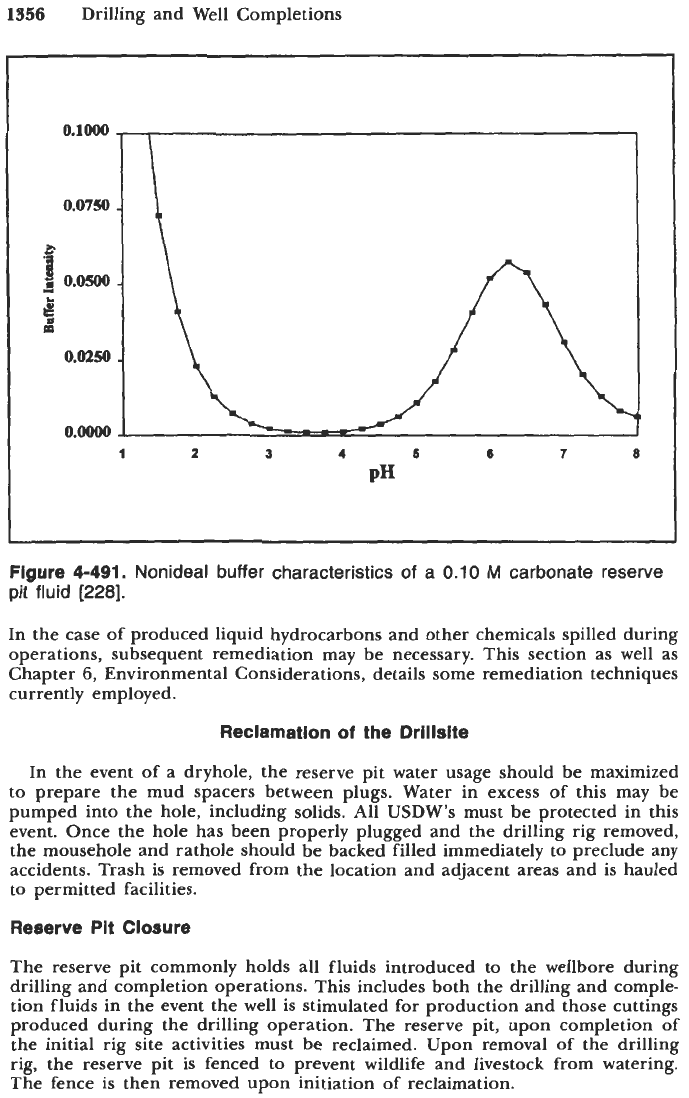
1356
Drilling and Well Completions
0.1Ooo
0.0750
f
I
0.0500
c
k
s
0.0250
O.oo00
1
2
3
4
I
8
7
8
PH
Figure
4-491. Nonideal buffer characteristics
of
a
0.10
M
carbonate reserve
pit fluid
[228].
In the case of produced liquid hydrocarbons and other chemicals spilled during
operations, subsequent remediation may be necessary. This section as well as
Chapter
6,
Environmental Considerations, details some remediation techniques
currently employed.
Reclamation
of
the Drillsite
In the event of a dryhole, the reserve pit water usage should be maximized
to prepare the mud spacers between plugs. Water in excess of this may be
pumped into the hole, including solids. All USDW’s must be protected in this
event. Once the hole has been properly plugged and the drilling rig removed,
the mousehole and rathole should be backed filled immediately to preclude any
accidents. Trash is removed from the location and adjacent areas and is hauled
to permitted facilities.
Reserve Pit Closure
The reserve pit commonly holds all fluids introduced to the wellbore during
drilling and completion operations. This includes both the drilling and comple-
tion fluids in the event the well is stimulated for production and those cuttings
produced during the drilling operation. The reserve pit, upon completion of
the initial rig site activities must be reclaimed. Upon removal of the drilling
rig, the reserve pit is fenced to prevent wildlife and livestock from watering.
The fence is then removed upon initiation of reclaimation.
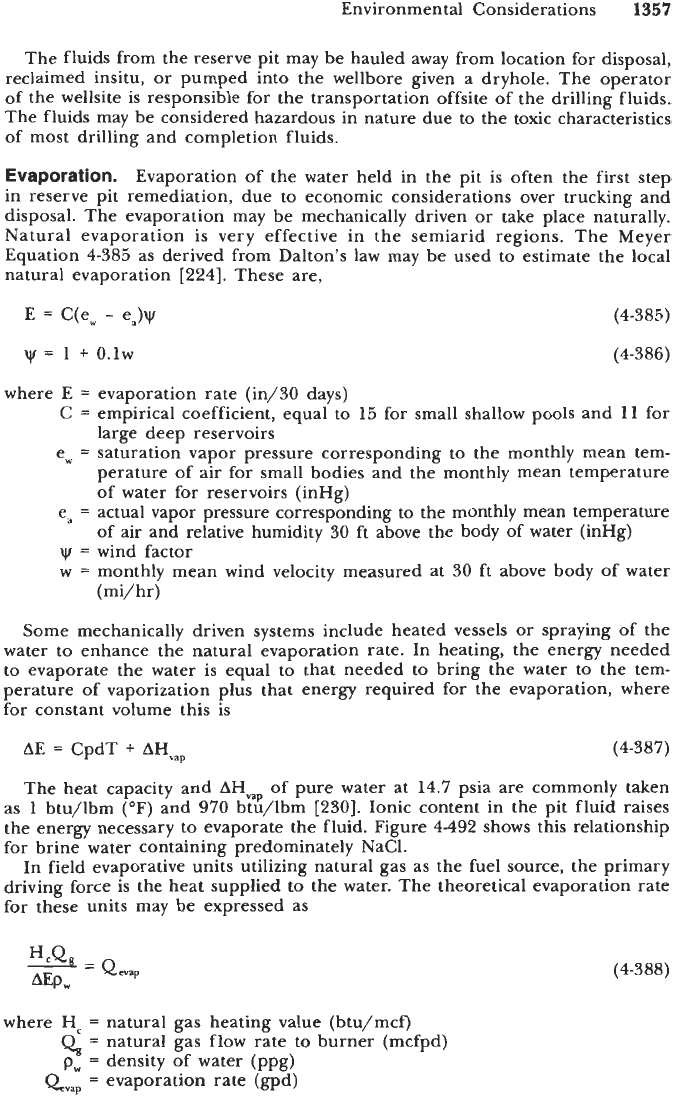
Environmental Considerations
1357
The fluids from the reserve pit may be hauled away from location for disposal,
reclaimed insitu, or pumped into the wellbore given a dryhole. The operator
of the wellsite is responsible for the transportation offsite of the drilling fluids.
The fluids may be considered hazardous in nature due to the toxic characteristics
of
most drilling and completion fluids.
Evaporation.
Evaporation of the water held in the pit is often the first step
in reserve pit remediation, due to economic considerations over trucking and
disposal. The evaporation may be mechanically driven
or
take place naturally.
Natural evaporation is very effective in the semiarid regions. The Meyer
Equation 4-385 as derived from Dalton’s law may be used to estimate the local
natural evaporation
[224].
These are,
E
=
C(e,
-
e,)v
(4-385)
ly=
1
+
where
E
=
C=
e,
=
ea
=
w=
w=
0.lw
(4-386)
evaporation rate (in/30 days)
empirical coefficient, equal to
15
for small shallow pools and
11
for
large deep reservoirs
saturation vapor pressure corresponding to the monthly mean tem-
perature of air for small bodies and the monthly mean temperature
of water for reservoirs (inHg)
actual vapor pressure corresponding to the monthly mean temperature
of air and relative humidity 30 ft above the body of water (inHg)
wind factor
monthly mean wind velocity measured at
30
ft
above body
of
water
(mi/hr)
Some mechanically driven systems include heated vessels or spraying
of
the
water
to
enhance the natural evaporation rate. In heating, the energy needed
to evaporate the water is equal to that needed to bring the water to the tem-
perature of vaporization
plus
that energy required for the evaporation, where
for constant volume this is
AE
=
CpdT
+
AHvap
(4-387)
The heat capacity and AHYIP of pure water at
14.7
psia are commonly taken
as
1
btu/lbm
(OF)
and
970
btu/lbm
[230].
Ionic content in the pit fluid raises
the energy necessary to evaporate the f
hid.
Figure
4-492
shows this relationship
for brine water containing predominately NaC1.
In field evaporative units utilizing natural gas as the fuel source, the primary
driving force is the heat supplied to the water. The theoretical evaporation rate
for these units may be expressed as
(4-388)
where Hc
=
natural gas heating value (btu/mcf)
=
natural gas flow rate to burner (mcfpd)
p,
=
density of water (ppg)
Q,,
=
evaporation rate
(gpd)
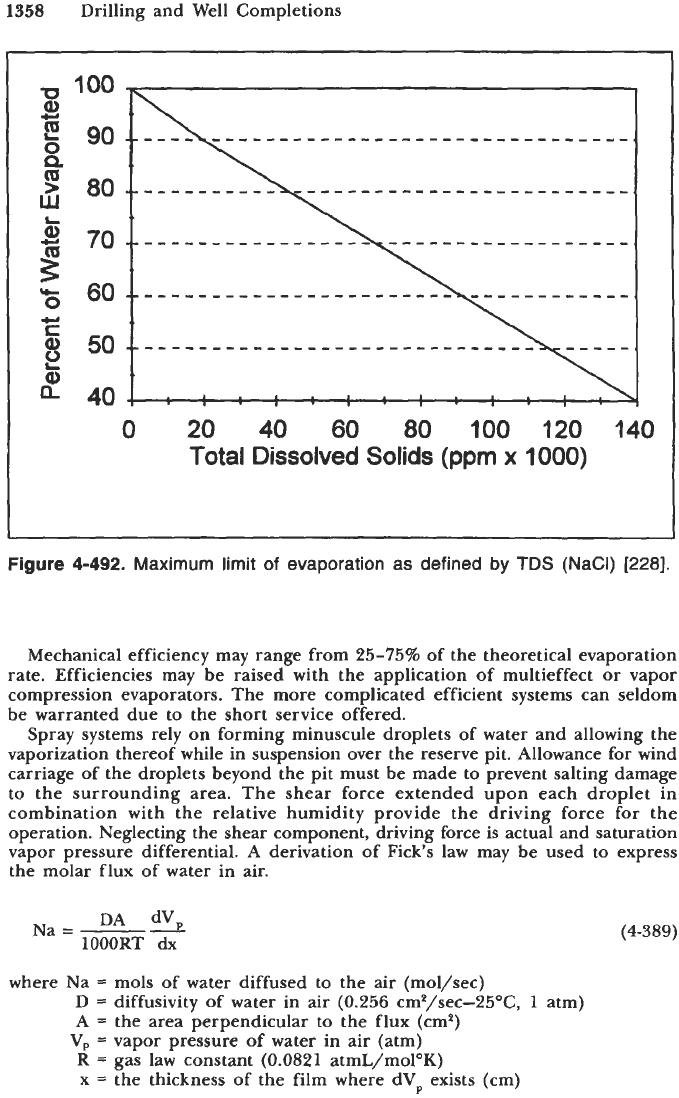
1358
Drilling and Well Completions
Mechanical efficiency may
range
from 25-75% of
the
theoretical evaporation
rate. Efficiencies may be raised with the application of multieffect
or
vapor
compression evaporators.
The
more complicated efficient systems can seldom
be warranted due to the short service offered.
Spray systems rely on forming minuscule droplets of water and allowing the
vaporization thereof while in suspension over the reserve pit. Allowance for wind
carriage of the droplets beyond the pit must be made to prevent salting damage
to the surrounding area.
The
shear force extended upon each droplet in
combination with the relative humidity provide the driving force for the
operation. Neglecting the shear component, driving force is actual and saturation
vapor pressure differential.
A
derivation of Fick's law may be used to express
the molar flux
of
water in air.
(4-389)
where Na
=
mols of water diffused to the air (mol/sec)
D
=
diffusivity of water in air
(0.256
cmp/sec--250C,
1
atm)
A
=
the area perpendicular
to
the flux (cm')
V,
=
vapor pressure of water in air (atm)
R
=
gas law constant
(0.0821
atmL/mol°K)
x
=
the thickness of the film where dVp exists (cm)
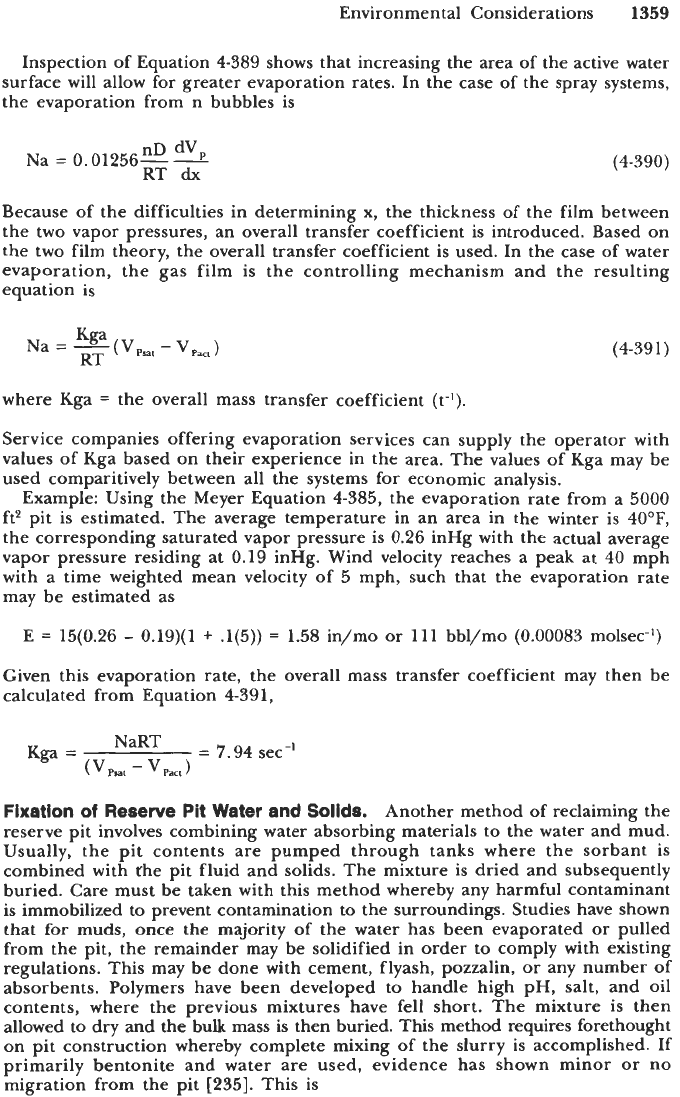
Environmental Considerations
1359
Inspection of Equation
4-389
shows that increasing the area of the active water
surface will allow for greater evaporation rates. In the case of the spray systems,
the evaporation from n bubbles is
nD dV
RT
dx
Na
=
0.01256-2
(4-390)
Because of the difficulties in determining x, the thickness of the film between
the two vapor pressures, an overall transfer coefficient
is
introduced. Based on
the two film theory, the overall transfer coefficient is used. In the case of water
evaporation, the gas film is the controlling mechanism and the resulting
equation is
Kga
Na
=
-
(V,
-
V,)
RT
(4-391)
where Kga
=
the overall mass transfer coefficient (t-I).
Service companies offering evaporation services can supply the operator with
values of Kga based on their experience in the
area.
The values of Kga may be
used comparitively between all the systems for economic analysis.
Example: Using the
Meyer
Equation
4-385,
the evaporation rate from a
5000
ft2 pit is estimated. The average temperature in an area in the winter is
40"F,
the corresponding saturated vapor pressure is
0.26
inHg with the actual average
vapor pressure residing at
0.19
inHg. Wind velocity reaches a peak at
40
mph
with a time weighted mean velocity of
5
mph, such that the evaporation rate
may be estimated as
E
=
15(0.26
-
0.19)(1
+
.1(5))
=
1.58
in/mo or 111 bbl/mo
(0.00083
molsec-')
Given this evaporation rate, the overall mass transfer coefficient may then be
calculated from Equation
4-391,
Fixation
of
Reserve
Pit
Water
and
Solids.
Another method of reclaiming the
reserve pit involves combining water absorbing materials to the water and mud.
Usually, the pit contents are pumped through tanks where the sorbant is
combined with the pit fluid and solids. The mixture is dried and subsequently
buried. Care must be taken with this method whereby any harmful contaminant
is immobilized to prevent contamination to the surroundings. Studies have shown
that
for
muds, once the majority
of
the water has been evaporated or pulled
from the pit, the remainder may be solidified in order to comply with existing
regulations. This may be done with cement, flyash, pozzalin, or any number
of
absorbents. Polymers have been developed to handle high pH, salt, and oil
contents, where the previous mixtures have fell short. The mixture is then
allowed to
dry
and the bulk mass is then buried. This method requires forethought
on pit construction whereby complete mixing of the slurry is accomplished.
If
primarily bentonite and water are used, evidence has shown minor
or
no
migration from the pit
[235].
This is
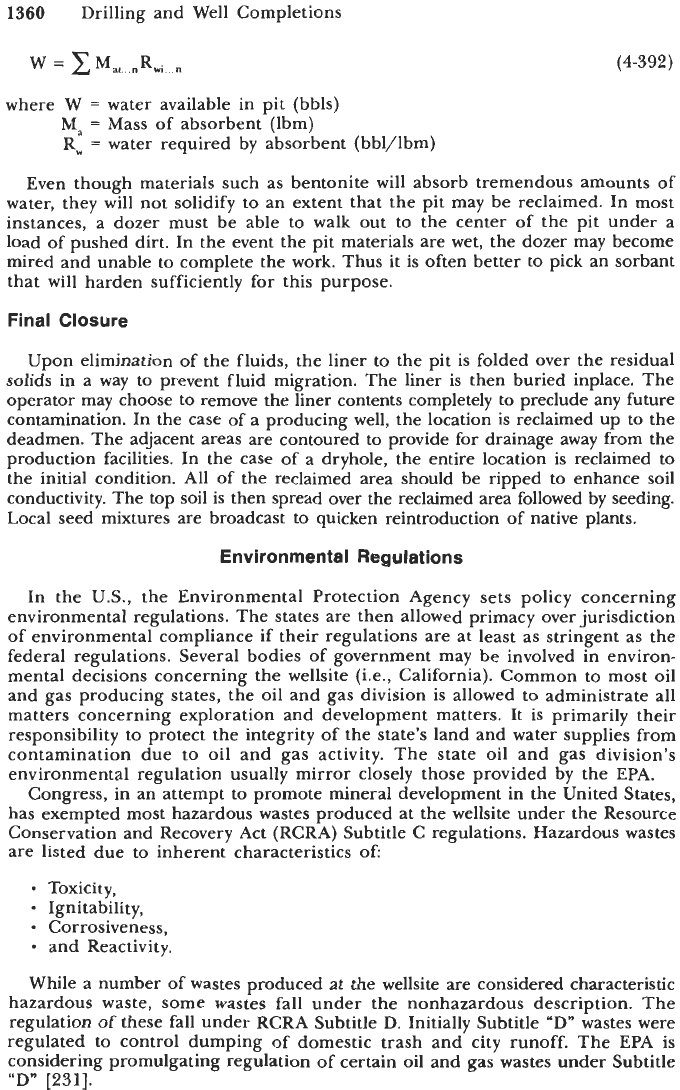
1360
Drilling and Well Completions
(4-392)
where
W
=
water available in pit (bbls)
Ma
=
Mass of absorbent (lbm)
Rw
=
water required by absorbent (bbl/lbm)
Even though materials such as bentonite will absorb tremendous amounts of
water, they will not solidify to an extent that the pit may be reclaimed. In most
instances, a dozer must be able to walk out to the center of the pit under a
load of pushed dirt. In the event the pit materials are wet, the dozer may become
mired and unable to complete the work. Thus it
is
often better to pick an sorbant
that will harden sufficiently for this purpose.
Final Closure
Upon elimination of the fluids, the liner to the pit is folded over the residual
solids in a way to prevent fluid migration. The liner is then buried inplace. The
operator
may
choose to remove the liner contents completely to preclude any future
contamination.
In
the case of a producing well, the location is reclaimed up to the
deadmen. The adjacent areas are contoured to provide for drainage away from the
production facilities. In the case of a dryhole, the entire location
is
reclaimed to
the initial condition. All of the reclaimed area should be ripped to enhance soil
conductivity. The top soil is then spread over the reclaimed area followed by seeding.
Local seed mixtures
are
broadcast to quicken reintroduction
of
native plants.
Environmental Regulations
In the
U.S.,
the Environmental Protection Agency sets policy concerning
environmental regulations. The states are then allowed primacy over jurisdiction
of environmental compliance
if
their regulations are at least as stringent as the
federal regulations. Several bodies
of
government may be involved in environ-
mental decisions concerning the wellsite (i.e., California). Common to most oil
and gas producing states, the oil and gas division is allowed to administrate all
matters concerning exploration and development matters.
It
is primarily their
responsibility to protect the integrity of the state’s land and water supplies from
contamination due to oil and gas activity. The state oil and gas division’s
environmental regulation usually mirror closely those provided by the EPA.
Congress, in an attempt to promote mineral development in the United States,
has exempted most hazardous wastes produced at the wellsite under the Resource
Conservation and Recovery Act (RCRA) Subtitle C regulations. Hazardous wastes
are listed due to inherent characteristics of:
-
Toxicity,
Ignitability,
*
Corrosiveness,
and Reactivity.
While
a
number of wastes produced at the wellsite
are
considered characteristic
hazardous waste, some wastes fall under the nonhazardous description. The
regulation of these fall under RCRA Subtitle
D.
Initially Subtitle
“D”
wastes were
regulated to control dumping of domestic trash and city runoff. The EPA is
considering promulgating regulation
of
certain oil and gas wastes under Subtitle
“D”
[231].
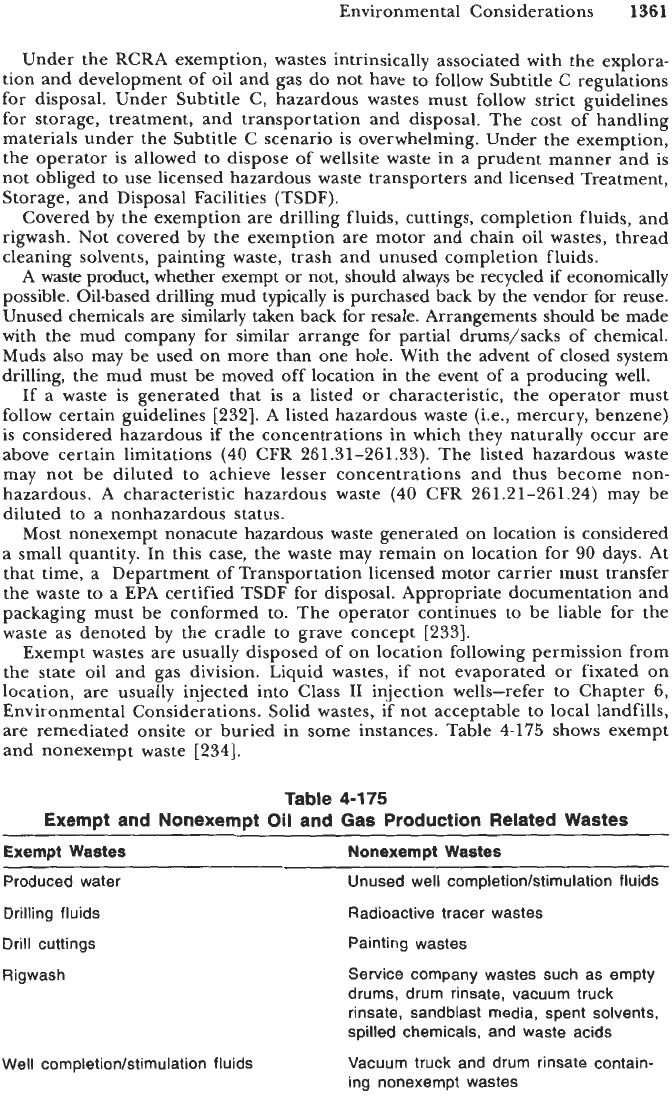
Environmental Considerations
1361
Under the RCRA exemption, wastes intrinsically associated with the explora-
tion and development of oil and gas do not have to follow Subtitle C regulations
for disposal. Under Subtitle C, hazardous wastes must follow strict guidelines
for storage, treatment, and transportation and disposal. The cost of handling
materials under the Subtitle C scenario
is
overwhelming. Under the exemption,
the operator is allowed to dispose of wellsite waste in a prudent manner and is
not obliged to use licensed hazardous waste transporters and licensed Treatment,
Storage, and Disposal Facilities (TSDF).
Covered by the exemption are drilling fluids, cuttings, completion fluids, and
rigwash. Not covered by the exemption are motor and chain oil wastes, thread
cleaning solvents, painting waste, trash and unused completion fluids.
A
waste
product, whether exempt or not, should always be recycled if economically
possible. Oil-based drilling mud typically is purchased back by the vendor for reuse.
Unused chemicals are similarly taken back for resale. Arrangements should be made
with the mud company for similar arrange for partial drums/sacks
of
chemical.
Muds also may be used on more than one hole. With the advent
of
closed system
drilling, the mud must be moved off location in the event of a producing well.
If a waste is generated that is a listed or characteristic, the operator must
follow certain guidelines
[232].
A listed hazardous waste (i.e., mercury, benzene)
is considered hazardous if the concentrations in which they naturally occur are
above certain limitations (40
CFR
261.31-261.33).
The listed hazardous waste
may not be diluted to achieve lesser concentrations and thus become non-
hazardous.
A
characteristic hazardous waste
(40
CFR
261.21-261.24)
may be
diluted to a nonhazardous status.
Most nonexempt nonacute hazardous waste generated on location
is
considered
a small quantity. In this case, the waste may remain
on
location for
90
days. At
that time, a Department of Transportation licensed motor carrier must transfer
the waste to a EPA certified TSDF for disposal. Appropriate documentation and
packaging must be conformed to. The operator continues to be liable for the
waste as denoted by the cradle to grave concept
[233].
Exempt wastes are usually disposed of on location following permission from
the state oil and gas division. Liquid wastes,
if
not evaporated or fixated on
location, are usually injected into Class I1 injection wells-refer to Chapter
6,
Environmental Considerations. Solid wastes, if not acceptable to local landfills,
are remediated onsite
or
buried in some instances. Table
4-175
shows exempt
and nonexempt waste
[234].
Table
4-175
Exempt and Nonexempt
Oil
and Gas Production Related Wastes
Exempt Wastes Nonexempt Wastes
Produced water
Drilling fluids
Drill cuttings
Rigwash
Well
completionlstimulation fluids
Unused well completionlstimulation fluids
Radioactive tracer wastes
Painting wastes
Service company wastes such as empty
drums, drum rinsate, vacuum truck
rinsate, sandblast media, spent solvents,
spilled chemicals, and waste acids
Vacuum truck and drum rinsate contain-
ing nonexempt wastes
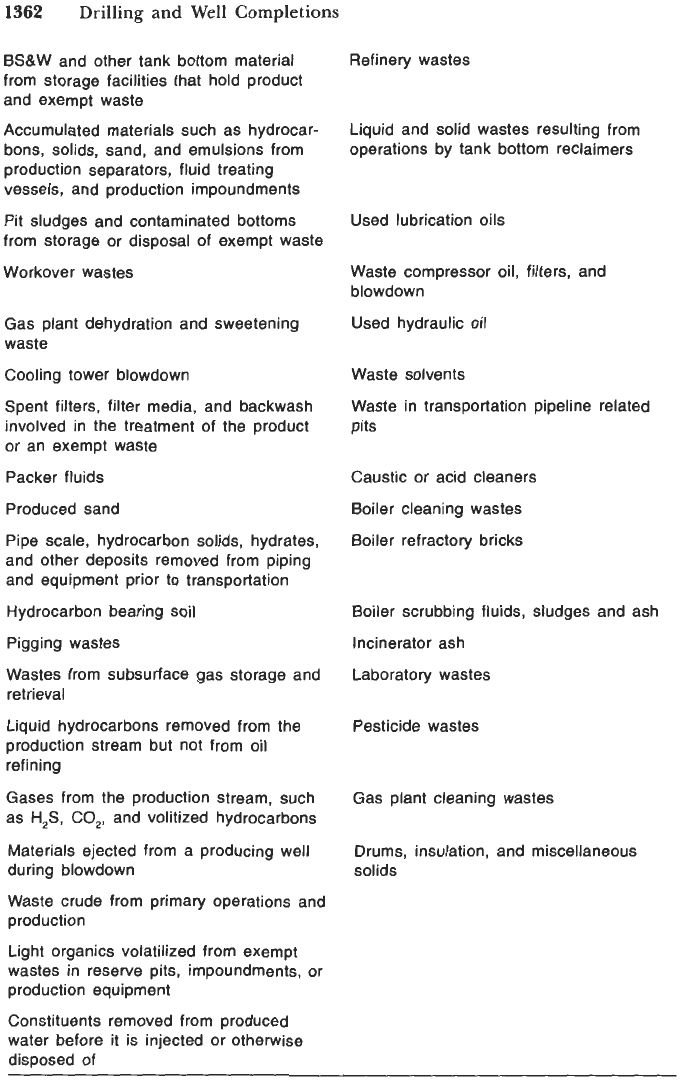
1362
Drilling
and
Well
Completions
BS&W and other tank bottom material
from storage facilities that hold product
and exempt waste
Accumulated materials such as hydrocar-
bons, solids, sand, and emulsions from
production separators, fluid treating
vessels, and production impoundments
Pit sludges and contaminated bottoms
from storage or disposal of exempt waste
Workover wastes
Gas plant dehydration and sweetening
waste
Cooling tower blowdown
Spent filters, filter media, and backwash
involved in the treatment of the product
or an exempt waste
Packer fluids
Produced sand
Pipe scale, hydrocarbon solids, hydrates,
and other deposits removed from piping
and equipment prior to transportation
Hydrocarbon bearing soil
Pigging wastes
Wastes from subsurface gas storage and
retrieval
Liquid hydrocarbons removed from the
production stream but not from oil
refining
Gases from the production stream, such
as
H,S, CO,,
and volitized hydrocarbons
Materials ejected from a producing well
during blowdown
Waste crude from primary operations and
production
Light organics volatilized from exempt
wastes in reserve pits, impoundments, or
production equipment
Constituents removed from produced
water before it is injected or otherwise
disposed of
Refinery wastes
Liquid and solid wastes resulting from
operations by tank bottom reclaimers
Used lubrication oils
Waste compressor oil, filters, and
blowdown
Used hydraulic oil
Waste solvents
Waste in transportation pipeline related
pits
Caustic or acid cleaners
Boiler cleaning wastes
Boiler refractory bricks
Boiler scrubbing fluids, sludges and ash
Incinerator ash
Laboratory wastes
Pesticide wastes
Gas plant cleaning wastes
Drums, insulation, and miscellaneous
solids
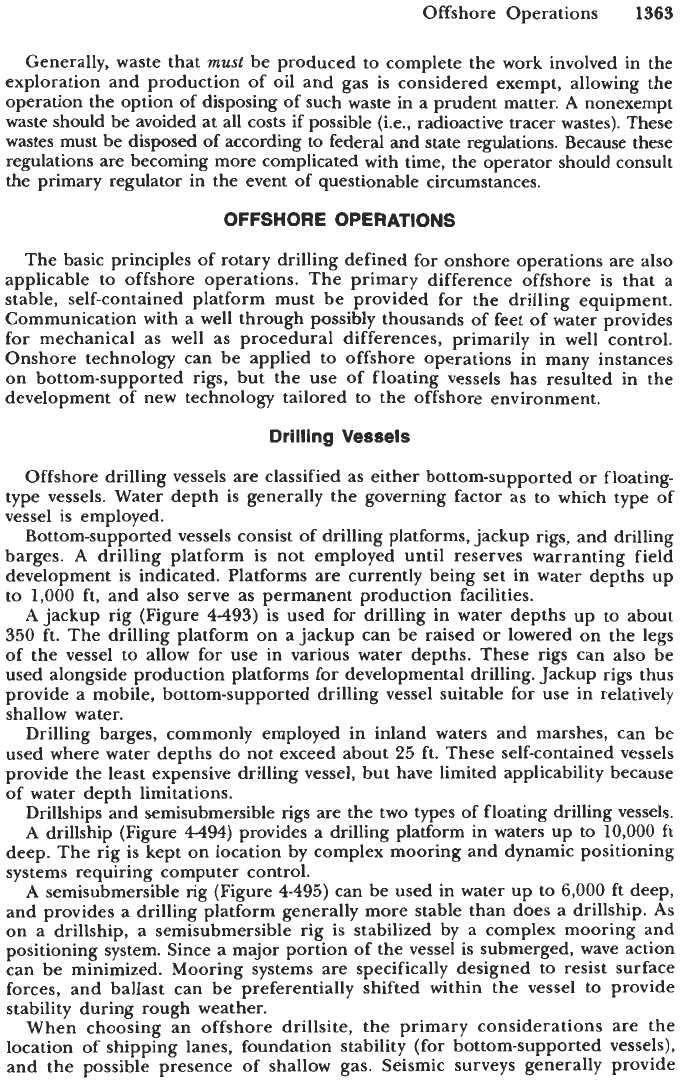
Offshore Operations
1363
Generally, waste that
must
be produced to complete the work involved in the
exploration and production of oil and gas is considered exempt, allowing the
operation the option of disposing of such waste in
a
prudent matter.
A
nonexempt
waste should be avoided at all costs if possible (i.e., radioactive tracer wastes). These
wastes must
be
disposed of according
to
federal and state regulations. Because these
regulations are becoming more complicated with time, the operator should consult
the primary regulator in the event of questionable circumstances.
OFFSHORE
OPERATIONS
The basic principles of rotary drilling defined for onshore operations are also
applicable to offshore operations. The primary difference offshore is that a
stable, self-contained platform must be provided for the drilling equipment.
Communication with
a
well through possibly thousands of feet of water provides
for mechanical as well as procedural differences, primarily in well control.
Onshore technology can
be
applied to offshore operations in many instances
on bottom-supported rigs, but the use of floating vessels has resulted in the
development of new technology tailored to the offshore environment.
Drilling
Vessels
Offshore drilling vessels are classified as either bottom-supported or floating-
type vessels. Water depth is generally the governing factor
as
to which type
of
vessel is employed.
Bottom-supported vessels consist of drilling platforms, jackup rigs, and drilling
barges.
A
drilling platform is not employed until reserves warranting field
development is indicated. Platforms are currently being set in water depths up
to
1,000
ft, and also serve as permanent production facilities.
A
jackup rig (Figure
4-493)
is used for drilling in water depths up to about
350
ft. The drilling platform on a jackup can be raised
or
lowered on the legs
of the vessel to allow for use in various water depths. These rigs can also be
used alongside production platforms for developmental drilling. Jackup rigs thus
provide
a
mobile, bottom-supported drilling vessel suitable for use in relatively
shallow water.
Drilling barges, commonly employed in inland waters and marshes, can be
used where water depths do not exceed about
25
ft. These self-contained vessels
provide the least expensive drilling vessel, but have limited applicability because
of water depth limitations.
Drillships and semisubmersible rigs are the two types of floating drilling vessels.
A
drillship (Figure
4-494)
provides a drilling platform in waters up to
10,000
ft
deep. The rig is kept on location by complex mooring and dynamic positioning
systems requiring computer control.
A
semisubmersible rig (Figure
4-495)
can be used in water up to
6,000
ft
deep,
and provides a drilling platform generally more stable than does a drillship.
As
on a drillship, a semisubmersible rig is stabilized by a complex mooring and
positioning system. Since a major portion of the vessel is submerged, wave action
can be minimized. Mooring systems are specifically designed to resist surface
forces, and ballast can be preferentially shifted within the vessel to provide
stability during rough weather.
When choosing an offshore drillsite, the primary considerations are the
location of shipping lanes, foundation stability (for bottom-supported vessels),
and the possible presence of shallow gas. Seismic surveys generally provide
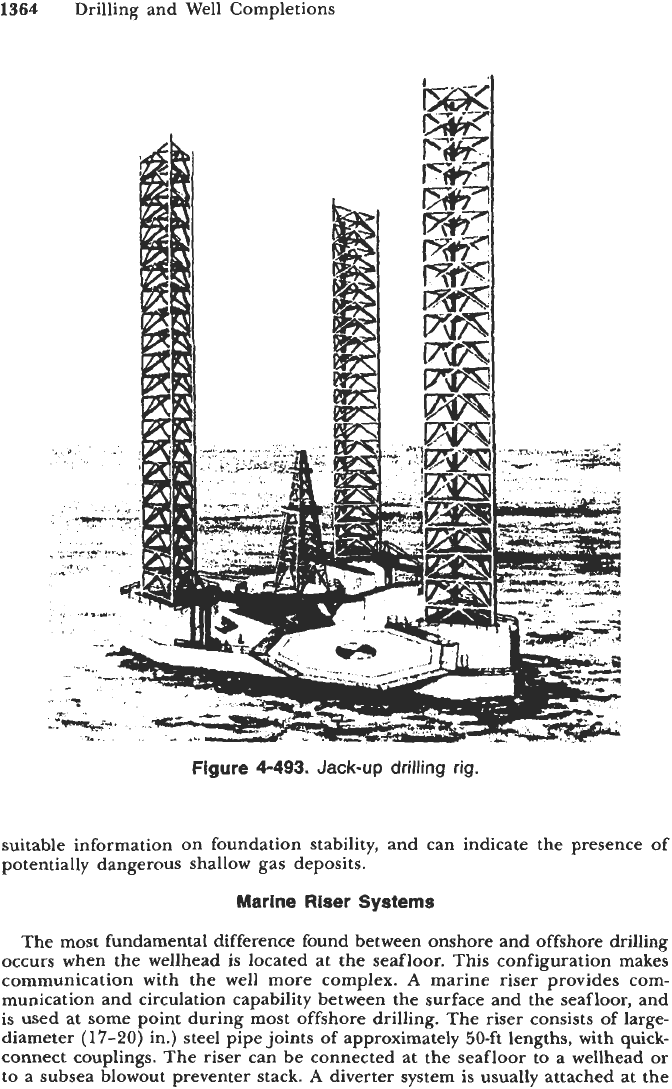
1364
Drilling and Well Completions
Figure
4-493.
Jack-up
drilling rig.
suitable information on foundation stability, and can indicate the presence of
potentially dangerous shallow gas deposits.
Marine
Riser
Systems
The most fundamental difference found between onshore and offshore drilling
occurs when the wellhead is located
at
the seafloor. This configuration makes
communication with the well more complex.
A
marine riser provides com-
munication and circulation capability between the surface and the seafloor, and
is
used at some point during
most
offshore drilling. The riser consists of large-
diameter
(17-20)
in.) steel pipe joints of approximately
50-ft
lengths, with
quick-
connect couplings. The riser can be connected at the seafloor to a wellhead or
to
a
subsea blowout preventer stack.
A
diverter system is usually attached at the
